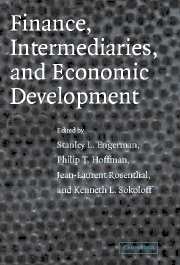Book contents
- Frontmatter
- Contents
- List of Contributors
- Preface
- Introduction
- I FINANCIAL INTERMEDIARIES IN EUROPE
- II FINANCIAL INTERMEDIARIES IN THE AMERICAS
- III OTHER FORMS OF INTERMEDIATION
- 7 Intermediaries in the U.S. Market for Technology, 1870–1920
- 8 Beyond Chinatown: Overseas Chinese Intermediaries on the Multiethnic North-American Pacific Coast in the Age of Financial Capital
- 9 Finance and Capital Accumulation in a Planned Economy: The Agricultural Surplus Hypothesis and Soviet Economic Development, 1928–1939
- 10 Was Adherence to the Gold Standard a “Good Housekeeping Seal of Approval” during the Interwar Period?
- Afterword: About Lance Davis
- Index
- References
10 - Was Adherence to the Gold Standard a “Good Housekeeping Seal of Approval” during the Interwar Period?
Published online by Cambridge University Press: 24 July 2009
- Frontmatter
- Contents
- List of Contributors
- Preface
- Introduction
- I FINANCIAL INTERMEDIARIES IN EUROPE
- II FINANCIAL INTERMEDIARIES IN THE AMERICAS
- III OTHER FORMS OF INTERMEDIATION
- 7 Intermediaries in the U.S. Market for Technology, 1870–1920
- 8 Beyond Chinatown: Overseas Chinese Intermediaries on the Multiethnic North-American Pacific Coast in the Age of Financial Capital
- 9 Finance and Capital Accumulation in a Planned Economy: The Agricultural Surplus Hypothesis and Soviet Economic Development, 1928–1939
- 10 Was Adherence to the Gold Standard a “Good Housekeeping Seal of Approval” during the Interwar Period?
- Afterword: About Lance Davis
- Index
- References
Summary
INTRODUCTION
Adherence to fixed parities and convertibility of national currencies into gold served as a signal of financial rectitude or a “good housekeeping seal of approval” during the classical gold standard era from 1870–1914. Peripheral countries that adhered faithfully to the gold standard rule had access at better terms to capital from the core countries of Western Europe than did countries with poor records of adherence (Bordo and Rockoff 1996). In this chapter we extend the approach to ascertain whether the “good housekeeping seal” was also an important institution under the interwar gold exchange standard, which prevailed only from 1925 to 1931.
In simplest terms, the “good housekeeping seal” hypothesis views the gold standard as a commitment mechanism. Adherence to the fixed parity of gold required that members follow domestic monetary and fiscal policies and have other institutions of financial probity (such as having a monetary authority that holds gold reserves) consistent with long-run maintenance of the fixed price of gold. It also signaled to potential overseas lenders that the borrowers were “good people.”
An important part of the hypothesis is that the gold standard should be viewed as a contingent rule or a rule with escape clauses. Members were expected to adhere to convertibility except in the event of a well-understood emergency such as a war, a financial crisis, or a shock to the terms of trade.
- Type
- Chapter
- Information
- Finance, Intermediaries, and Economic Development , pp. 288 - 318Publisher: Cambridge University PressPrint publication year: 2003
References
- 2
- Cited by

